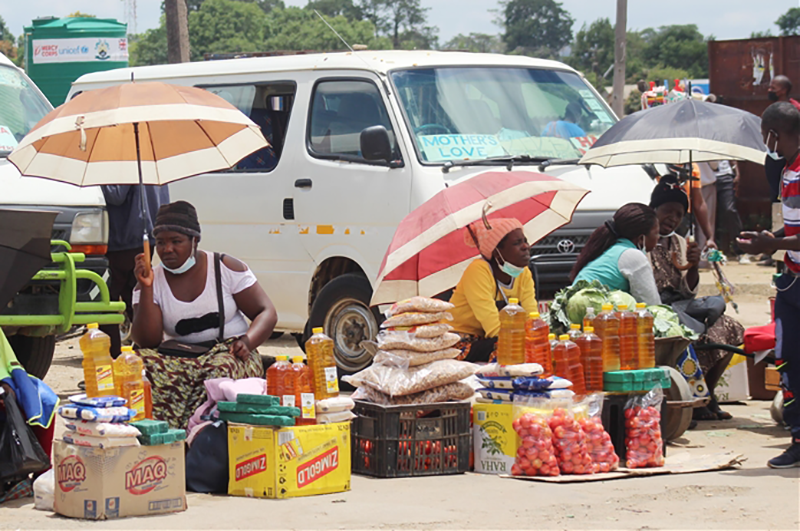- Featured
- No Comment
In Zimbabwe, hyperinflation meets its match on the streets

By Anadolu News Agency
In Bloomingdale, a middle-income suburb in Harare, a makeshift roadside stall locals call “Okey” is witnessing a business boom like never before.
Every day, people queue up to buy daily essentials, from vegetables to bars of soap, things for which they would normally head to supermarkets.
Others make their way to areas where vendors have turned their cars into sort of mobile supermarkets, selling all imaginable groceries outside high-end shopping malls.
This is all the impact of hyperinflation in Zimbabwe, a country blighted by currency instability and immense economic problems for more than 15 years now.
In 2008, hyperinflation in Zimbabwe peaked at an estimated 500 billion percent. It currently stands at around 176%, while all forecasts for the country paint a picture of doom and gloom with no real prospects of a turnaround on the horizon.
In these trying times, street vendors and informal markets have become a panacea for the crippling crises, largely because they have shunned the Zimbabwean dollar, which lost more than three-quarters of its value between January and early June.
It currently trades at around 5,500 for one US dollar.
According to the UNDP, Zimbabwe already has the world’s second-biggest urban informal economy, with more than 60% of the population depending on informal activities to generate income.
As formal supermarkets still use the Zimbabwe dollar, they are forced to keep adjusting their prices to keep pace with the plummeting currency.
Makeshift stalls like Okey, which are known locally as tuckshops, and the “car supermarkets,” on the other hand, are selling goods smuggled from neighboring countries and price everything in US dollars.
“I buy my orders from South Africa and I sell in US dollars here. The currency is stable, meaning I have no reason to fear inflation,” Timothy, owner of a makeshift stall in central Harare, who did not want to use his real name, told Anadolu.
‘Everyone to the tuckshops’
However, many Zimbabweans do not have access to US dollars, leaving them with no option but to dole out exorbitant amounts for basic things.
Social media, particularly Twitter, is brimming with such stories.
One user narrated how they bought a notebook for over 11,000 Zimbabwean dollars, while another complained about being asked for 55,000 Zimbabwean dollars for a pack of three bream fish.
“Everyone to the tuckshops,” a person with the username Bright Hurumbukwa chimed in on the same thread.
Loveness Nhekairo, a 46-year-old resident of Harare’s Ashdown Park locality, told Anadolu that the informal markets have become the only source of survival for many people.
“I can’t even step into the supermarkets. The prices there are just staggering. But at these tuckshops and other stalls, it seems that our inflation problem does not exist,” said Nhekairo.
Economists also agree that using the US dollar is proving beneficial for both sellers and buyers.
“When a producer supplies to the large, formal shops, they are paid in local currency. The markets then include a huge risk premium, making the products much more expensive,” Carren Pindiri, an economist and lecturer at the University of Zimbabwe, told Anadolu.
Tichaona Zivengwa, another economist at the same university, warned that the “exchange rate dynamics in Zimbabwe” spell major trouble for formal businesses.
“Large firms are compelled to sell in local currency, which is volatile, meaning they do cost plus markup pricing … done in a way to avoid selling stock below cost in light of the money exchange rate depreciating weekly,” said Zivengwa.
This is not sustainable and could devastate these businesses in the long run, he added.
While informal vendors seem to be getting the better end of the bargain at the moment, a top union official pointed out that they are also feeling the effects of the unending economic crisis.
“We are all victims of hyperinflation. The only difference has been in our ability to adapt and come up with coping strategies,” said Samuel Wadzai, director of the Vendors Initiative for Social and Economic Transformation.
As Zimbabwe gears up for general elections next month, the economic crisis will be the top issue for voters and could well decide if they hand President Emmerson Mnangagwa a second term, or favour Nelson Chamisa, the 45-year-old lawyer and pastor who leads the Citizens Coalition for Change.
